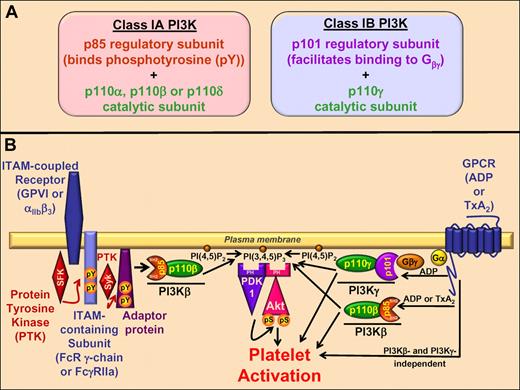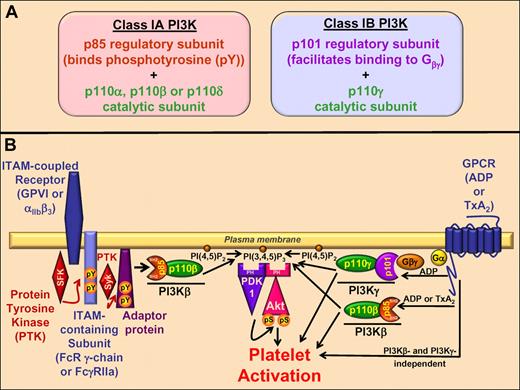Abstract
In this issue of Blood, Canobbio and colleagues report on the unique and redundant contributions of 2 isoforms of PI3K, PI3Kβ and PI3Kγ, to platelet activation by GPCRs and ITAM–coupled receptors.1
Phosphoinositide 3-kinases (PI3Ks) constitute a family of lipid kinases that phosphorylate the 3-hydroxyl group of phosphatidyl inositol (PtdIns), as well as the phosphoinositides PtdIns-4-phosphate [PI(4)P] and PtdIins-4,5-bisphosphate [PI(4,5)P2], to generate PI(3)P, PI(3,4)P2, and PI(3,4,5)P3, respectively, on the inner leaflet of the plasma membrane.2 Members of the PI3K family are grouped into 3 classes (classes I, II, and III) based on their structural properties and substrate specificities. Class I PI3Ks are heterodimers composed of a 110-kDa catalytic subunit (p110) and a regulatory subunit, whereas class II and class III PI3Ks each consist of a single catalytic subunit.2 The ability to generate PI(3,4,5)P3 is unique to class I PI3Ks, which are the only PI3K family members that can use PI(4,5)P2 as a substrate.2 All of the lipid products of PI3Ks support recruitment of pleckstrin homology (PH) domain–containing proteins that propagate transduction of an activating signal; however, the lipid product PI(3,4,5)P3 has garnered particular attention because it serves as a high-affinity docking site for the PH domains of the serine/threonine kinases Akt (also known as protein kinase B or PKB) and 3-phosphoinositide–dependent protein kinase 1 (PDK1).3 Once recruited to locations in the membrane where class I PI3Ks are active, PDK1 phosphorylates and activates Akt, which goes on to phosphorylate multiple target molecules that control cell metabolism, survival, proliferation, and motility.4
(A) Subunit composition and mechanism of activation of class IA and IB isoforms of phosphoinositide 3-kinase (PI3K). (B, left) Engagement of GPVI or αIIbβ3 activates of a Src family kinase (SFK), which phosphorylates tyrosine residues on an immunoreceptor tyrosine-based activation motif (ITAM)–containing subunit. Phosphotyrosine (pY) residues support binding and activation of spleen tyrosine kinase (Syk), which phosphorylates downstream adaptor molecules. The Src homology 2 (SH2) domains of the p85 subunit of PI3Kβ bind to pY-containing proteins, activating the p110β catalytic domain to convert PI(4,5)P2 to PI(3,4,5)P3 on the inner leaflet of the plasma membrane. The pleckstrin homology (PH)–domain-containing molecules 3-phosphoinositide–dependent protein kinase 1 (PDK1) and Akt bind to PI(3,4,5)P3, enabling PDK1-dependent activation of Akt and subsequent platelet activation. Canobbio et al found that platelets expressing a kinase dead form of PI3Kβ, or those that express a kinase dead form of PI3Kγ and are treated with a PI3Kβ-specific inhibitor, fail to respond to GPVI- or αIIbβ3-specific stimuli. These results indicate that GPVI- and αIIbβ3-dependent responses require p110β activity. (B, right) Binding of the G protein–coupled receptor (GPCR) ligands adenosine diphosphate (ADP) or thromboxane A2 (TxA2) activates PI3Kβ via an unknown mechanism, and also results in binding of the p101 subunit of PI3Kγ to dissociated Gβγ subunits, which activates the p110γ catalytic subunit to generate PI(3,4,5)P3 and induce Akt and platelet activation as described above. Canobbio et al found that platelets expressing kinase dead forms of either PI3Kβ or PI3Kγ fail to phosphorylate Akt but do aggregate in response to treatment with ADP. The same is true of platelets expressing a kinase dead form of PI3Kβ, or of those that express a kinase dead form of PI3Kγ and are treated with a PI3Kβ-specific inhibitor, in response to treatment with a TxA2 analog. These findings suggest that GPCRs can activate platelets in a manner that is independent of PI3Kγ and/or PI3Kβ activity, and that is independent of Akt activation.
(A) Subunit composition and mechanism of activation of class IA and IB isoforms of phosphoinositide 3-kinase (PI3K). (B, left) Engagement of GPVI or αIIbβ3 activates of a Src family kinase (SFK), which phosphorylates tyrosine residues on an immunoreceptor tyrosine-based activation motif (ITAM)–containing subunit. Phosphotyrosine (pY) residues support binding and activation of spleen tyrosine kinase (Syk), which phosphorylates downstream adaptor molecules. The Src homology 2 (SH2) domains of the p85 subunit of PI3Kβ bind to pY-containing proteins, activating the p110β catalytic domain to convert PI(4,5)P2 to PI(3,4,5)P3 on the inner leaflet of the plasma membrane. The pleckstrin homology (PH)–domain-containing molecules 3-phosphoinositide–dependent protein kinase 1 (PDK1) and Akt bind to PI(3,4,5)P3, enabling PDK1-dependent activation of Akt and subsequent platelet activation. Canobbio et al found that platelets expressing a kinase dead form of PI3Kβ, or those that express a kinase dead form of PI3Kγ and are treated with a PI3Kβ-specific inhibitor, fail to respond to GPVI- or αIIbβ3-specific stimuli. These results indicate that GPVI- and αIIbβ3-dependent responses require p110β activity. (B, right) Binding of the G protein–coupled receptor (GPCR) ligands adenosine diphosphate (ADP) or thromboxane A2 (TxA2) activates PI3Kβ via an unknown mechanism, and also results in binding of the p101 subunit of PI3Kγ to dissociated Gβγ subunits, which activates the p110γ catalytic subunit to generate PI(3,4,5)P3 and induce Akt and platelet activation as described above. Canobbio et al found that platelets expressing kinase dead forms of either PI3Kβ or PI3Kγ fail to phosphorylate Akt but do aggregate in response to treatment with ADP. The same is true of platelets expressing a kinase dead form of PI3Kβ, or of those that express a kinase dead form of PI3Kγ and are treated with a PI3Kβ-specific inhibitor, in response to treatment with a TxA2 analog. These findings suggest that GPCRs can activate platelets in a manner that is independent of PI3Kγ and/or PI3Kβ activity, and that is independent of Akt activation.
The class I PI3K subfamily is divided into 2 subclasses (IA and IB) on the basis of the regulatory subunit with which the p110 catalytic subunit associates. This in turn determines the nature of the receptors with which p110 will be brought into proximity as well as the mechanism by which p110 is activated (see panel A of the figure). The catalytic subunits of class IA PI3Ks, of which there are 3 (p110α, p110β, and p110δ), associate with 1 of 5 regulatory subunits, collectively referred to as p85, to create a PI3Kα, PI3Kβ, or PI3Kδ heterodimer, respectively.2-4 Binding of p110α, p110β, or p110δ to p85 maintains the class IA PI3K in an inactive conformation in resting cells; however, p85 contains 2 Src homology 2 (SH2) domains that are capable of binding to phosphotyrosine residues on receptors or adaptor molecules.3,4 Binding of p85 to phosphotyrosine-containing molecules at the plasma membrane serves to recruit and activate class IA PI3Ks at locations along the plasma membrane where tyrosine kinases have been activated. Consequently, class IA PI3Ks are activated primarily by receptor tyrosine kinases (RTKs) or immunoreceptor tyrosin-based activation motif (ITAM)–coupled receptors that use tyrosine kinases to initiate signal transduction. Instead of associating with p85, the catalytic subunit of the sole member of the class IB subfamily of PI3Ks (p110γ) associates with 1 of 2 alternative regulatory subunits, including p101 and the p101 homologue, p84 (also known as PI3Kγ adaptor protein of 87 kDa or p87PIKAP), to create the PI3Kγ heterodimer.3 The p101 and p84/87 regulatory subunits are thought to facilitate activation of p110γ by G protein βγ subunits.2 Consequently, PI3Kγ is not activated by events that trigger tyrosine kinase activity but is instead activated by G protein–coupled receptors (GPCRs). Interestingly, PI3Kβ, but not other class IA PI3Ks, shares with PI3Kγ the ability to be activated by GPCRs; however, the mechanism underlying GPCR-mediated activation of p110β is not well understood.2,3
The work of Canobbio et al in this issue of Blood contributes to an extensive and growing body of literature that has defined an important role for PI3K activity in platelet activation by GPCRs and ITAM-bearing receptors.5 They make use of 2 types of new tools, specifically, a PI3Kβ-specific small molecule inhibitor and genetically engineered mice that express “kinase dead” forms of PI3Kβ and PI3Kγ, to define the relative importance and specific functions of PI3Kβ and PI3Kγ in platelet activation by different agonists. They demonstrate that PI3Kβ and PI3Kγ activities each contribute minimally and redundantly to platelet activation by the GPCRs for ADP and thromboxane, in a manner that is at least partially uncoupled from their involvement in Akt activation (panel B, right, in the figure). More importantly, they show that PI3Kβ activity is uniquely required for platelet activation by GPVI and αIIbβ3, both of which use ITAM-containing signaling subunits to activate platelets (panel B, left, in the figure). These findings are comfortingly compatible with our understanding of the mechanisms by which PI3Kβ and PI3Kγ are activated (ie, PI3Kβ can be activated by both GPCRs and tyrosine kinase-activating receptors, whereas PI3Kγ is activated only by GPCRs). Furthermore, the results are useful in that they focus our attention on PI3Kβ as the sole PI3K isoform involved in GPVI- and αIIbβ3-mediated platelet activation.
Conflict-of-interest disclosure: The author declares no competing financial interests. ■



